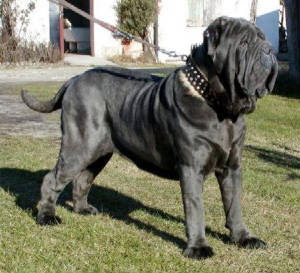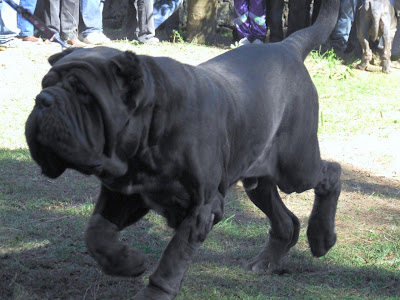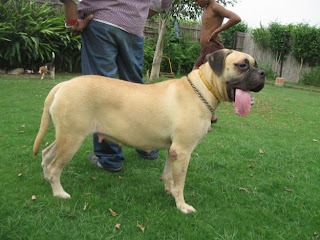The Neapolitan Mastiff should be well boned, large, heavy built, strong and muscular. They should not look like a Great Dane. The height can range between 24 - 31 inches at the shoulder with a weight from 140 to 180 pounds, although some are lighter and some are heavier. Neapolitan Mastiff must also be balanced; it is not required to have a dog so big (fat) that it cannot move correctly. The Neapolitan Mastiff must have a degree of loose fitting skin over the body and head but this must not be overly excessive so that it is detrimental to the health of the breed. The head must be square and flat between the ears (not round or have low set overly long ears). They must have a double dewlap and, the required feature of the lips forming an upside-down ‘V’. There are four colours, all shades of grey, black, mahogany and ash blond, all these coats may be brindled.
Owning a Neapolitan Mastiff can be the beginning of a wonderful relationship with hopefully many years of happiness, however, it could also be the beginning of an overwhelming responsibility, which you just weren’t prepared for!!. This information sheet has been compiled to help you and your family consider the Pro’s & Con’s of ownership and, with your own careful and honest consideration, will ensure that you and your family have enough understanding to reach your informed decision about Neapolitan Mastiff ownership.
Neapolitan Mastiff are high maintenance, time consuming, smelly, slobbery and because of their size, constantly under your feet! Neapolitans are also devoted, loving, loyal, charismatic companions, gentle giants with their family, fearful foe to the intruder. Neapolitans are generally very good with children, especially if brought up with them but, they can be a bit clumsy and at times excitable, so great care should be taken around babies and toddlers. Older children should always be involved in the training and socialisation of your puppy; this will encourage balance and harmony for your adult dog within your family unit. Socialisation and Obedience training is very important, you must be in control of your dog at all times. Training must NOT be based on punishment or negative reinforcement, but on instruction and repetition of commands, giving praise and reward for good behaviour will generally have the desired affect. If you do not have the time for training and socialisation regimes then a Neapolitan Mastiff is not the breed for you.
Neapolitan Mastiff can be very good around other dogs and cats, as long as they have been raised with them but as adult Neapolitans do have a very high Alpha drive they can be intolerant of other dogs if not socialised as a puppy. If you already live with an adult male we urge you to consider a female as a companion and vice versa. If you have no previous experience of dominant alpha breeds, a Neapolitan Mastiff is not the breed for you. Neapolitan Mastiffs make wonderful companions, they are not dogs that should be left to their own devices outside or chained up all day long. They are loving animals that thrive on human companionship. If your house is too small for a very large dog to interact with your family unit, then a Neapolitan is not the breed for you.
Some Neapolitans naturally slobber more than others but they all slobber a lot after they eat or drink. Are you prepared for wiping down floors, walls and ceilings, several times a day after your dog has shook his head and the slobber has flown everywhere? Slobber towels, kitchen roll and newspaper around water bowls are a must, as is the weekly chore of washing dewlap and wiping down of folds. If you haven’t the time for daily or weekly rituals, then a Neapolitan is not the breed for you. Some Neapolitans also snore very badly, if you or your children are a light sleepers, a Neapolitan Mastiff is not the breed for you. Once over their major growing stage, Neapolitans will eat two meals a day, preferably from feeding stands. Their food must be good quality and low in protein; it does make all the difference if they are fed the correct food. An adult Neapolitan Mastiff can get through roughly £30-£50 worth of food in one month alone. Veterinary fees will be more expensive for a giant breed due to their size and weight, so health insurance is also a must, as is a vehicle large enough to transport a Neapolitan. If you are not prepared for financial commitment then a Neapolitan is not the breed for you.
The average lifespan of a Neapolitan Mastiff is approximately 6 to 8 years although we all know of dogs that have lived 10 to 12 years. As with all giant breeds there can be health problems, which can occur during the optimum growing period, so a controlled diet is essential. Do not over feed at puppy stage as this places too much stress on growing limbs; a fat puppy does not make a large boned puppy. Neapolitans can suffer with hip dysphasia and elbow dysphasia but no more so than any other large breed. Neapolitans can be, because of their lowered immune system, prone to infections of the skin, especially during periods of stress, which they are also prone to suffering from.
They can also suffer with eye problems like cherry eye, entropion or ectropion, which will require the services of your Vet, but again these problems occur in other breeds like the Bloodhound, Bassett Hound, Sharpei & Bulldog, so there is no real evidence to suggest that Neapolitans are any different to other breeds with facial folds and wrinkles. However, all issues of health need to be considered, for the chances of your Neapolitan Mastiff living into old age having never suffered any health problems, is highly unlikely. Have you considered all issues of Health?
Breed Characteristics
The Neapolitan Mastiff should be steady, loyal, vigilant, intelligent and slightly aloof. The typical breed characteristic of movement is at walk; the gait is slow, free and rolling due to the unique construction of the breed their movement becomes almost cat like. Neapolitan Mastiffs are not attack dogs and should never be trained to be so. These dogs will naturally guard their family and house and they are apt at protecting their family by their mere presence, but if you accept someone into your house, your dog should accept that person also. However, they can be very territorial and will protect their garden, house, car, and family, from people or other dogs, this is why socialisation and training is very important, it is your responsibility to teach your dog what they are allowed or not allowed to do.
Neapolitan Mastiff Breed Type
Breed type is an issue that is raised time and time again but we still seem unclear about what constitutes real type. The Italian type, the European type, the American type, what is the correct Type?! The Neapolitan Mastiff Club President, Douglas Oliff, has written many a word on the subject reminding us that: Breed Type stems from the Italian Neapolitan Mastiff, but even in Italy there are two types, the Naples Mastini and the Northern region Mastini. When the breed first appeared in the UK we were importing specimens from Italy, Germany and America, and we saw a great deal of variation, in size, type and temperament.
We had long narrow headed Dane types, short legged Bulldog types, Mastiff types that had the size and substance but lacked the folds and looseness of the skin, and the Bloodhound type that had the folds and looseness of skin but were domed headed with long low set ears. It is only now; 30 years after the Neapolitan Mastiff first appeared on this Isle, can we say that our Neapolitan Mastiff connoisseurs are beginning to see continuity of type. We have, since the turn of the century, seen great improvements in the health and type of Neapolitan Mastiffs being bred in the UK Suffice to say that: the Neapolitan Mastiff remains a ‘Rare Breed’ in the UK with only a handful of true Mastino breeders, but then, with a breed as unique as the Mastino is, would we really want it any other way?.















0 comments:
Post a Comment